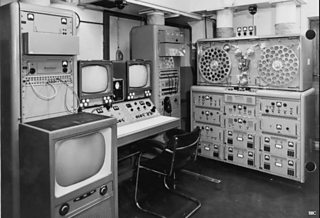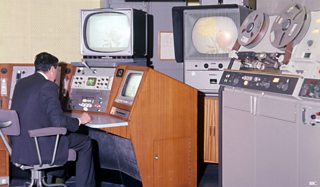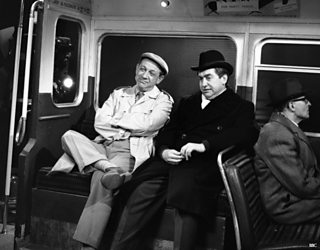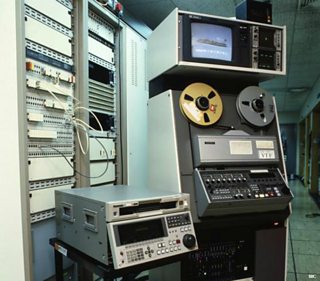
The ��������'s own home-grown video recorder, VERA. Good luck installing that in your living room...
Some time ago we discussed early methods of recording television programmes, and how they were all based around filming the image on the television screen. Now we're going to have a look at how this was replaced by an electronic method – videotape recording.
Film telerecording was expensive because it involved a medium which could only be used once. It also took time to process so it was not possible to instantly play back the recording that had been made. Early telerecording gave a much cruder result than the original television picture, and while methods increased in sophistication over the years, some of the drawbacks persisted.
The obvious answer to these problems was to devise a method of directly recording the electronic signals of the television picture, and by the 1950s scientists were hard at work on producing such a system.
The American company Ampex, named after its founder Alexander M. Poniatoff, was started in 1944 and became involved in developing captured German audio tape technology. Sound tape recording had been invented before the war and one version, the , was used by the ��������. This used steel tape which ran at very high speeds, and had to be operated in a sealed room due to the danger of the tape breaking, which could have had lethal results.
The Germans had developed a cheaper and safer system that used plastic tape, and it was this that Ampex made into a mass market product. The system came to the notice of Bing Crosby, who was attracted by the ability to record his radio shows, which had previously had to be performed twice, for East and West Coast audiences, due to the time zone difference. The networks had refused to meet the high cost of making disc recordings of the shows, but audio tape provided a more economical solution.
It was soon clear that a video version of this technology would also be highly useful for similar reasons. Avoiding the effort and expense of performing shows twice, it would likewise save the costs of telerecording (or in American parlance ‘kinescoping’) programmes, which resulted in a low quality picture anyway. Video tape (the term being originally an Ampex trade mark) gave a similar picture quality to live television, and had the advantage of being reusable – the recording could be wiped off and the tape used for another show at a later date.

A �������� videotape suite in 1968 operated by a man in a �������� videotape suit (very comfortable but you have to keep it away from magnets)
This ability would of course one day come to be a controversial feature, rather than an advantage. Videotape was relatively expensive but the cost was intended to be amortised over a number of uses, rather than being seen as an archival medium – if a recording was intended to be kept for historical reasons, it could be telerecorded onto film.
Ampex’s videotape system was demonstrated to the US television trade in 1956 and was soon employed in programme making. At first live transmissions were recorded as they were broadcast, but it was soon realised that programmes could be recorded at any time, for the artists’ (or anyone else’s) convenience, and several shows could even be made in one day, saving studio time.
Since 1952, meanwhile, the �������� had been working on its own videotape system, called VERA (Vision Electronic Recording Apparatus) which was demonstrated publicly on on 14 April 1958. The system seemed to provide all that was required of it: it instantly replayed vision and sound, and the tape could be wiped and reused time and again.
After showing a clip from recorded earlier that evening, presenter Richard Dimbleby interviewed Peter Axon, head of the team who had developed VERA, and the machine was shown in action. However VERA used very large reels of narrow tape (Ampex tape was 2” wide with much smaller diameter reels). The tape travelled over the fixed recording heads at a great speed and could only record for fifteen minutes – it also had problems of picture stability. The proven effectiveness of the Ampex machine meant that VERA’s days were numbered and it never went into regular service.
By the end of 1958 the Corporation had taken delivery of its first Ampex machines and put them into service. The first broadcast use made of videotape by the �������� was a trailer for the opera , but it was not long before it was being used for complete programmes.
It did take some time for the �������� to see the full advantages of videotape however. The �������� was not faced with the same kind of time zone issues as America, and there was a prevailing mindset that live television was somehow purer than recording programmes in advance. The fact that mistakes occurred in live programmes was seen as authentic and programme makers talked of not ‘cheating’ the viewer with what were then referred to as ‘bottled’ programmes.
Nevertheless, it was not simple to correct errors with early videotape, other than by restarting the recording of the programme, so it would be some time before productions would appear to be flawless – but some of the worst disasters could be avoided.

On the bus to East Cheam: Sidney Balmoral James and Anthony Aloysius St. John Hancock in a videotaped Hancock's Half Hour in 1960
Among the first users of videotape at the �������� was the top-rated comedy . Tony Hancock was a perfectionist, but also a highly instinctive performer, frustrated by the technical difficulties inherent in any kind of broadcasting. When making radio programmes he had to be dissuaded from too much rehearsal in case his performance lost its spark. Television was another matter, for unlike radio he could not keep the script in his hand; he had to learn it, and in his live television episodes there was no way of correcting mistakes.
Some of his shows were telerecorded onto film for repeat, but still show him joking his way out of fluffs – on one notorious occasion however, in the episode , a number of trick effects – bits of a house collapsing due to aircraft noise – happened before they were due to. The cast had no option but to muddle through the rest of the episode, but the experience was shattering for the highly-strung Hancock. (It could have been worse, fellow comedian Charlie Drake was once knocked unconscious during the climax of one of his .)
Videotape seemed to offer a way out of such problems. Hancock saw the advantage of being able to make his shows in pieces, rather than running straight through. His producer, Duncan Wood, had a fight on his hands to make that a reality. Electronic editing of videotape was not yet possible, the only way of editing was to physically cut the tape with a razor blade, and this had inherent problems.
As the video signal was recorded in a succession of short diagonal stripes, due to the arrangement of four recording heads on a wheel, it was necessary to make sure you were not cutting through any of these stripes. A fluid was developed which would make the stripes visible, enabling the engineer to select a safe place to make the edit.
There was also the issue of sound – it was not possible to have the sound recording head in the same place as the video heads, so there was a gap between where the picture and sound for a given shot were recorded on the tape. There were two ways round this – to cut when the picture had faded to black and the sound had been faded out, or to dub the sound onto audio tape and redub it later.
Since a physical cut could cause a fault in any new recording on the tape, making more than a handful of edits in any programme was severely frowned upon. Programmes then had to be recorded in a single session over a very few hours, as if they were live. Re-recording too many sequences would meant that the recording time increased, and with that the production cost.
Hancock was nevertheless soon an enthusiast for videotape. Duncan Wood demonstrated the possibility of editing smoothly by cutting some items out of an existing programme, and wary of upsetting one of their biggest stars, the �������� agreed to the new production process.

The shape of things to come (once upon a time) - on the right a 1" tape machine assembly, dwarfing the comparatively portable D3 machine on the left.
It was still to be some time before videotape became ubiquitous for most non-topical programmes. Z Cars was nearly always ‘live’ in its original run, from 1962 to . Other dramas such as Softly Softly, Mogul and play series also had some live editions, in the latter case as late as 1968. Even these series were not averse to using videotape for sequences which it would be impossible to achieve ‘live’, as an alternative to pre-filming them.
By the late 60s it started to become possible to edit without cutting up the tape. This process was achieved by locking together the output of two or more videotape machines to produce a master recording on another tape. This was not always easy to achieve however, as tape could not be searched in vision. By the early 70s, videotape editors began to be credited on particularly complex programmes to reflect their increasingly important contribution.
By the end of the 1970s things would change again, with a system employing 1” wide tapes, which could be searched in vision. The machines were lighter and easier to use, and the tape was helically scanned, which meant that the recording was in a very long, nearly horizontal stripe along the tape, and thus would be impossible to edit physically – not that anyone needed to by then.
2” videotape vanished as a medium for new productions during the early 1980s, but it had been a versatile medium in its time which had revolutionised television production. Even 1” was not to rule for too long, with each successive tape format lasting roughly half as long as its predecessor.
Cassette tape media were coming in during the 1980s, and soon the buzzword would be ‘digital’ – superseding analogue technology, and the ��������’s broadcast standard format was established as D3 in the early 90s. Few suspected that by the early 21st Century, tape itself would start to be on its way out too – and we would be looking forward to the brave new world of tapeless production and file based delivery.
Any retired technicians out there with tales of the old days of video recording? Tell us your anecdotes, and dazzle us with your knowledge of time-base errors. Was videotape a good idea? Or did video kill the radio star? You know where to tell us...
